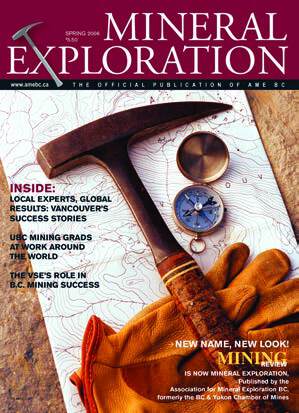The 1981 inaugural issue of Mining Review (now Mineral Exploration) confirms that mineral exploration and mining companies were grappling with environmental and social issues long before toolkits and other resources for applying corporate social responsibility (CSR) were readily available.
Summing up comments from a panel of mine operators at the BC & Yukon Chamber of Mines annual general meeting (the predecessor to AME BC’s Roundup), the Review reported that “meeting environmental controls and standards” was one of the major “problems” inherent in almost any new mine.
Dave Barr, then vice-president of DuPont of Canada Exploration Ltd., noted that more than 25 permits were required for the newly opened Baker gold-silver mine in the Toodoggone region of B.C., resulting in added costs and delays. Environmental concerns were heightened as the air-supported mine was situated near B.C.’s largest caribou preserve in the Spatsizi/Stikine wilderness. The company had to hire wildlife consultants to carry out long-term studies and prepare an environmental report to prove that the mine and the caribou could coexist. “Part of the objective,” Barr stated, “is to lay groundwork for future operations in similar situations.” The groundwork paid off, as exploration in the Toodoggone continued well into the mid-1980s, culminating with the opening of the Lawyers (Cheni) gold-silver mine in 1989.
Barr also helped lay the groundwork for Canada’s first exploration safety manual, released in 1981 by the Chamber. (The manual has since been reissued several times, with more than 30,000 copies distributed by 2015.)
Subsequent issues of the Review reveal that the environment took a back seat to the economy after a brutal recession hit in 1982. Gold discoveries in Ontario’s Hemlo camp came as welcome relief, as half of the 130,000 mine workers in Canada had been facing some type of layoff. By the mid-1980s, junior companies were back in the game with a series of impressive discoveries, notably in the “Golden Triangle” of northwestern B.C.

First Nations signalled they wanted resource jobs and benefits too, and a standoff between operators of the Golden Bear mine near Dease Lake, B.C., and the Tahltan Nation resulted in the first impact benefit agreement ever signed in the province. Mining Review subsequently reported that the Golden Bear project was “living proof that native land claims and the mining industry don’t have to be on a collision course in B.C.”
In the late 1980s, Mining Review featured numerous articles about proposed land withdrawals for parks and wilderness areas, most of them critical in tone. Nick Carter, outgoing Chamber president in 1989, warned that the mining industry “must assume a proactive rather than a reactive role with respect to the important issue of land use.”
By the early 1990s, however, the industry faced another downturn and came under siege on other fronts. The New Democratic Party (NDP) won the 1991 election in B.C., and media-savvy green groups were waging big-budget campaigns against forestry and mining. The world-class Windy Craggy copper-cobalt-gold deposit was locked up as part of a park, a loss aptly described by Mining Review as “a crushing blow to B.C.’s mining industry.”
In 1999, the Chamber withdrew from the “dysfunctional” NDP land planning process, citing the “major damage” it was doing to the rural economy of B.C. By this point, many companies were pursuing foreign projects in more miningfriendly jurisdictions. After a period of reflection, the Chamber adopted a more proactive role to prepare the industry for a new century, not just at home but also abroad. The change in mindset was reflected in a 2002 article in Mining Review entitled, “Two Cultures of Sustainable Development.”
Authors Susan Joyce and Ian Thomson called for a “new relationship between mining and society” because “in many countries, mining is no longer considered socially acceptable.” The industry dilemma, they noted, “is how to balance environmental and social initiatives and become socially acceptable in both worlds: the developed world where there are head offices with shareholders and financial institutions looking on, and the developing world where, increasingly, mines and exploration projects are located.”
Subsequent issues of Mining Review continued to reflect a progressive and proactive approach to CSR issues, including Aboriginal engagement. “Without local community support, your project is going nowhere,” Mining Review warned in the summer of 2003.
A change of government soon improved B.C.’s investment climate, reflected by exploration spending of $220 million in 2005.

The “Chamber” became AME BC that year, and in 2006 Mining Review was rebranded Mineral Exploration. Another milestone was the release in 2005 of the original Aboriginal and Community Engagement Guidebook, supported by 32 First Nations, the B.C. and federal governments, and more than 30 organizations.
AME BC has contributed to other CSR initiatives, including the Environmental Excellence in Exploration (e3) initiative of the Prospectors & Developers Association of Canada, and has been an intervener in court cases related to mine permitting. Most recently, in May 2015, AME BC released a revised edition of its Aboriginal Engagement Guidebook. The CSR committee is focused on sharing information about cost-effective ways that companies can use CSR to add value to their properties – a vital role given the present downturn (see article on page 33).
Together, Mining Review and Mineral Exploration have chronicled the evolution of CSR for 35 years, with the tone of reporting also evolving over time. Environmental and social issues are no longer “problems”; they’re opportunities to gain social acceptance. And through editorials and guest columns, AME BC and industry leaders continue to reinforce the message that CSR is essential for the survival of a safe, economically strong and environmentally responsible mineral exploration and development industry.
